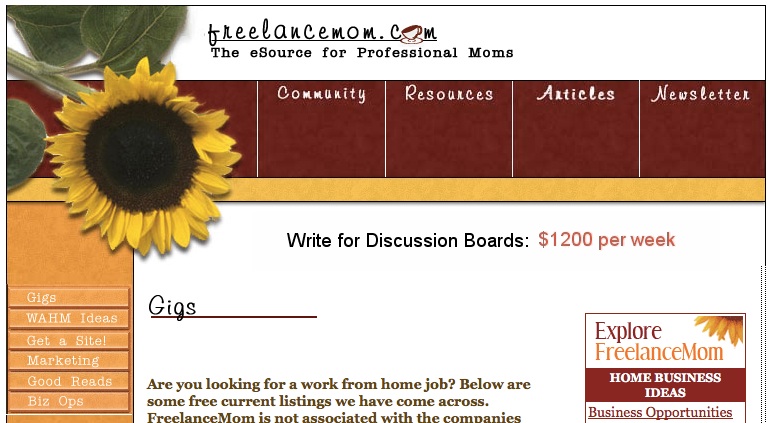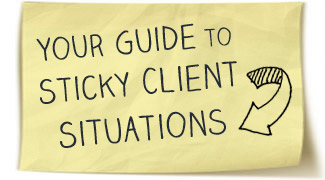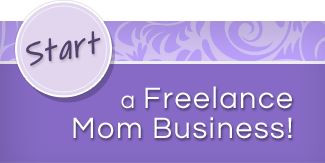
Old design of site when I purchased it.
I was recently featured on a website I love, The Work at Home Woman in a whopping 3300-word profile on how to buy an established blog, how to avoid the mistakes I made and how to make it your own.
Those of you that follow FreelanceMom probably know a little bit of background about me and how I came to run this site, but the post on The Work at Home Woman goes though the whole process. However, I wanted to share a few highlights with you here, since it can be hard to make time to read a five page blog post in one go!
How I Decided to Buy a Website
Before we had our first daughter, Gabby, I worked in sales and then the learning department at IBM, which is where I learned the value of education through example, particularly in the case of business skills training.
When Gabby was born, I left IBM and started teaching business courses at a local college, but I realized that I only understood the corporate side of business, not the entrepreneurial side. Most of my students were not taking my class to go work for corporations, but because they wanted to work for themselves.
I turned to Flippa.com, a site for buying pre-existing websites, and after seeing a few niche sites that weren’t really up my alley, I found a mom entrepreneur website that was making $4,000 a month. The price was more than we wanted to spend, but then I found Freelancemom.com, and thought: if the other site in this niche is making so much and carries such a high value, why can’t I bring Freelancemom.com up to that level?
From my research on the other mom entrepreneur blog, I could see how she was making money, and I sought to replicate the same results here on FreelanceMom, focusing on advertising, affiliate marketing, and creating and selling my own products.
Holly, from Work at Home Woman, has a great e-book about all three.
Growing FreelanceMom into My Own Website
When I first took over the site, I posted every day, because that was the previous model, but I realized that was at odds with my goal for the site.
I only want to publish content that offers SIGNIFICANT value.
Posting everyday was good for traffic, but not engagement, and having a strong community is central to my conception of FreelanceMom.
Though the site has been making some money since purchasing it, and I’ve made a profit some months and had some consistent advertisers, I’ve learned that engagement is the first step to growing a profitable blog.
While pregnant with and nursing my second daughter, I’ve cut down the hours I devote to the site considerable, but it was something I was only doing part-time initially as well, and I know this is the case for many moms looking to grow their businesses.
When I hired a business coach who specializes in working with small businesses, she said something to me that really opened my eyes, that I think is so relevant for all of you as well.
She asked me how many hours I work a week.
Once I told her 10 to 15 hours, she said “Lisa, what would take you a year to do, will probably take you four or so years to accomplish since you only can dedicate 10 to 15 hours a week.”
“So don’t worry too much about your progress and growth right now, because it will come, but it will just come slower than you are used to.” That really helped me put things in perspective.
Looking to Buy Your Own Website? What You Need to Know
There were several things that I did, especially early on, that created hurdles I wish we didn’t have to jump over (If you want even more information and insights, head on over the the longer article I wrote on The Work at Home Woman site).
Here are some of my mistakes that I hope you can learn from and avoid in your own endeavors:
- Don’t negotiate on your dreams. Stick to the hard numeric value of the asset and compare it to the cost of building the same thing from scratch yourself.
- Don’t overvalue outdated (whether old software or old engagement numbers) portions of the asset. It may take more time and effort to revive those areas than is worth it.
- Look out for out-of-date content that will require a significant investment to update and factor the price of that process into your negotiation.
- Determine the engagement of the website’s audience and the value of that engagement. The website I passed on was able to make $4,000 per month because of the engagement of its audience, not simple traffic or email numbers.
- Drill down on the numbers the seller gives you regarding engagement. The site may have a 3,000-person email list, but what are the open, bounce and reply rates, and how often do they receive messages?
While there are going to be positives and minuses of any website you might purchase, it’s important to find the best fit for you. Once you know the cold, hard facts about the site, its engagement, and its current and potential future monetization, you need to take an equally cold, hard look at yourself.
Before buying and running your own website, it’s impossible to understand all the different things that go into it, but take stock of:
- your skills and background vs. what you need to run the website (you’ll either need to invest time in learning or money in outsourcing to make up for any deficits)
- the time you realistically can and want to commit to the business
- the amount of money you have available for the initial purchase as well as on-going expenses
- the relationship between a website’s asking price and profit potential (website owners want 4x to 5x yearly profit, but you should really pay 1x to 2x)
I am so happy I went through this process because the learning I have gained is invaluable. I wouldn’t have changed a thing.
Have you bought a website or jumped into another business and learned valuable lessons in the process you can share with other FreelanceMom readers?





